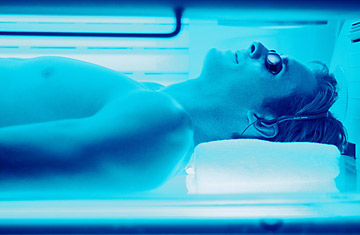
What is a tanorexic to do? Baking yourself on the beach to a crispy bronze husk is a no-no, according to studies showing that ultraviolet radiation from the sun can scramble your DNA and cause cancer. And now comes equally bad news about the tanner's next best friend, the indoor tanning salon. Last week the International Agency for Research on Cancer (IARC), the cancer division of the World Health Organization, classified tanning beds as "carcinogenic to humans" — the agency's highest cancer-risk category, which also includes radon gas, plutonium and radium.
Since 1992, the beds had been deemed "probably carcinogenic to humans." But in the past 17 years, "many more studies have been published, in many countries and in many populations, concluding that exposure to sun beds causes cancer," says Beatrice Secretan, one of the scientists involved in the new IARC classification. In an analysis of 20 such studies, the IARC found that people who begin using tanning beds before age 30 increase their risk of developing skin cancer 75%. Overall, use of the beds boosts the risk of melanoma, the deadliest form of skin cancer, 20%.
Is that warning enough to deter the 28 million Americans who use the booths every year? The Indoor Tanning Association, which oversees the $5 billion annual business of tanning-bed makers, distributors and salon owners, certainly hopes not. On the association's website, it continues to promote tanning-bed use as a health benefit: in response to the FAQ "Is moderate exposure to the sun or ultraviolet light (UV) good for your health?" the answer reads cheerfully, "Absolutely. There is a growing body of well-conducted, validated scientific research demonstrating that the production of the activated form of vitamin D is one of the most effective ways the body controls abnormal cell growth."
Nobody would argue with the fact that UV rays — whether of the outdoor or indoor variety — can help your body make more vitamin D, but the more salient question is, How does that benefit stack up against the risk of skin cancer from UV exposure? "My role is not to tell you what the risk is. My role is to give you the other side of the story about the benefits of UV exposure," says Dan Humiston, president of the Indoor Tanning Association, adding, "Most people are vitamin D deficient, and one of the easiest way to prevent that — it's simple, it's free — is to go out in the sun. Or go into a tanning bed, and your skin produces vitamin D."
Talk to any doctor, however, and he or she will tell you flat out, the risk far outweighs any benefit. "There are so many other forms of getting vitamin D that are healthier than a tanning booth," says Dr. Ellen Marmur, chief of the division of dermatologic and cosmetic surgery at Mount Sinai Medical Center. "Go for a 10-minute walk three times a week or eat salmon or tuna or eggs or fortified cereal. You don't need to use a dangerous habit like a tanning booth to get vitamin D."
Marmur, like most other dermatologists, says the message of the IARC report is clear: "What I'm really hoping for is that people will opt out of using tanning beds."
